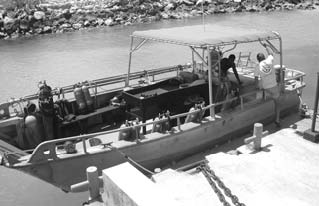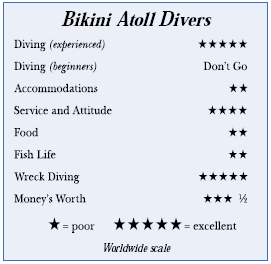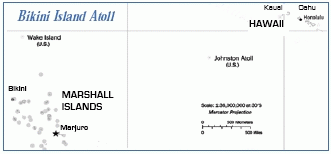The WWII Wrecks of Bikini Atoll, Marshall IslandsContents of this Issue: The WWII Wrecks of Bikini Atoll, Marshall Islands DAN-Insured Divers Remain Fully Covered in Chamber Dispute Four Cases of Divers Drifting at Sea: Mistakes Galore Putting Spring Straps in Your Kick An Artificial Gill for Divers? When Divers Get Benched: Part II Editorial Office: Ben Davison Publisher and Editor Undercurrent 3020 Bridgeway, Suite 102 Sausalito, CA 94965 for skilled divers with a second mortgage from the April, 2006 issue of Undercurrent
Dear Reader: “Welcome to Majuro, your stopover on the way to Bikini. I’m Brenda from Bikini Atoll Divers and I’ve got a surprise for you. You two are the only divers this week.” Wow. After months of planning and accumulating the bits and pieces that form a technical diving rig, my buddy and I were to get a personalized trip to the WWII wreckdiving mecca, Bikini Atoll. We had completed our IANTD Advanced Nitrox training five months before our September trip and had two post-certification dives with double rigs to our credit. My 582 dives before the advanced training provided only basic skills to carry over to the radical departure from sport diving to tech diving. And my financial skills helped me figure out whether I should take out a second mortgage to afford the jaunt. Majuro, five hours west of Hawaii by 737, is a wispy, elongated figure eight of sand, rock, coral and palm trees. After overnighting in a bare-bones hotel, we departed at 6:30 a.m. on Air Marshall Islands’ 12-seater, the bigger Dash-8 being down with maintenance problems. Aloft, I could see long stretches of blue sea sliding by, then tiny wisps of atolls, dry brushstrokes of aqua, green, and amber.
Bikini is a
Cold War remnant.
In 1946, after
relocating the 167
indigenous Bikinians
against their wishes,
the US anchored
a flotilla of discarded
ships in the
lagoon to “test” the
effects of nuclear
blasts. When Test
Able, an air-burst, sank only five ships, the U.S. government
ordered Test Baker and suspended a
20-kiloton atomic bomb 100 feet below the
lagoon’s surface. The detonation sent
the ships to the bottom, including the
aircraft carrier USS Saratoga, battleship
USS Arkansas, destroyers USS Anderson and
USS Lamson, and others. The captured
Japanese battleship HIJMS Nagato, from
which the order was given to attack Pearl
Harbor, did not sink -- an embarrassment
to the US military. After landing three hours later on the grass strip on Eneu Island, we were met by British expat Jim Akroyd, American Gennifer Hansen (now Jim’s wife) and Chris Storey (who has since left). Jim is general manager and head dive guide of Bikini Atoll Divers, which is owned by the Bikini government. Gen is a dive guide and fills in with guest services. Each has long tech diving experience and is immensely competent. Their competence is needed. A week’s diving consists of 12 decompression dives, breathing air, to depths up to 185 feet. The atoll’s remoteness makes shipping helium too expensive, so there is no trimix. You can bring a rebreather, as long as you bring all your supplies. The operation makes its own oxygen, using 75 percent EANx for decompression. If someone gets bent, there is plenty of oxygen for the up to 24-hour’s wait for Air Marshall to take you to the Kwalajein chamber, an hour flight away. While dive insurance is mandatory, Jim told us of a Japanese diver, a heavy smoker, who suffered a hit and waited a day for the plane to take her to Kwajalein, where she learned her dive insurance had lapsed. Her symptoms did not resolve, so she had to charter a jet to wave-hop back to Japan. Trip and treatment: $125,000. Getting unbent. Priceless. Twin 85 cu. ft. steel tanks were outfitted with non-DIN valves, and never had less than 3400 psi; I often had 1800 psi left when I got to the deco ladders. Single tank divers get 104 cu. ft. steel tanks. Dive time ran up to 90 minutes, with bottom time usually 20-30 minutes. Jim, Chris, and Gen were on all dives, and everyone stayed together, a firm rule. There is a nifty set-up of horizontal pipes roped down to 30, 20, and 10 feet with Scubapro R190 second stages dangling from Nitrox tanks on the dive boat. Depending on the current, I could spend my deco suspended over the wreck I just dived or hanging in the blue. Sometimes bat fish or gray reef sharks circled the rack. Each diver must carry two mixed gas computers. Models such as all Oceanic, US Divers Matrix, Sherwood Source, Genesis, and Dacor computers aren’t recommended. Jack Niedenthal, tourism manager for the Bikini Atoll government, says “they were not designed for diving that involves substantial decompression obligations on every dive. Dive computers like the Oceanic typically lock up after three dives on Bikini Atoll.” Recommended computers are listed on their Web site. The afternoon of our arrival, we made a checkout dive on the upright U.S.S. Saratoga. Comfortable in a 3mm wet suit, I descended under a bright sun into 84F water with 60-ft. visibility. The flight deck stretched into invisibility. Swimming past the bridge to the flight deck, we dropped over the side to the antiaircraft guns at 105 ft. and did a modest penetration of the gunnery cabins. We ascended to the pilot house, which held gas masks, speaking tubes, bottles and mugs, the ship’s clock, the ship’s bugle, and a bit of whimsy -- a clarinet hidden in a low set of shelves. Here we took a convenient 80 ft. two-minute stop, then rose to 45 ft. to the top of the bridge for another two-minute stop, where I looked through the contents of an open toolbox. We then hit the rack for five minutes at 30 ft., 10 minutes at 20 ft., and 15 minutes at 10 ft. or until our computers cleared. As my nitrogen loading increased during the week so did time I spent on the rack. The second day we jumped into the back of the truck for the mile ride to the dock. Twenty minutes later we hit the destroyer USS Lamson, upright at 150 feet. We toured the racks of loaded depth charge racks and continued to the torpedo launcher, with four live “fish” in place. Speaking of fish, there are plenty: three-banded anemone fish endemic to the Marshalls, titan triggers, grey reef sharks, snappers, jacks, barracuda, Moorish idols, bat fish, and so on. But, when my partner interrupted Jim’s briefing on the 16-inch guns aboard the HIJMS Nagato to ask about fish, he sputtered “You’re diving in the greatest wreck museum in the world. We’re not here to talk about fish. We’re here to talk about the guns!” And the guns on the Nagato, coated in whispery lavender rope coral, are massive and dark, beneath the inverted ship at 165 feet, aged malevolence today aimed at nothing. Look quickly, you won’t be there long. The battleship USS Arkansas, like the Nagato, rolled over after the explosion and lies bottom up. After visiting the 12-inch forward guns at 160 ft., we checked out a gunnery cabin with a dresser, its drawers still open. We swam beyond the ship to the sand and turned to regard the bow looming out of the murk like the blade of a giant ghostly axe. Reversing course, we swam up the hull to the huge gash where the nuclear blast had pierced three layers of 12-inch armor and sent the ship down. Inside the rent I could see naval fuel oil floating atop captive sea water. Between the morning and afternoon dives I read, hung out on the porch listening to the Pacific lapping at the shore, watched videos in the briefing room, and sometimes walked through the coconut groves to the beach to collect shells or follow trails in the sand to turtle nests. Swimming in the morning or evening is unwise. “These are shark-infested waters,” Jim said “and that’s when they feed. If you must go, please tell me so I can take pictures.” The Spartan air-conditioned rooms were cleaned daily and furnished with fresh towels, shampoo, and soap. Amenities included such luxury appointments as a dresser, and one lamp. (I borrowed a second lamp from an empty room.) The only queen-size bed is in the “honeymoon suite.” The dining hall (no A/C) is adorned with pictures of visiting dignitary divers,
charts and wreck souvenirs. Scientific studies find that radiation exposure
on the islands is minimal, provided visitors don’t eat locally grown food, so it’s
all imported. And don’t drink the coconut milk. Stick-to-your-ribs food seemed
designed to help you survive lengthy decompression dives –- except the chili,
which may have the opposite effect. Breakfast was eggs with bacon, ham, or sausage;
cold cereal; fruit; and toast. Lunch was build-your-own sandwiches, soup,
burgers; perhaps a stir-fry or pizza, and baked cookies. Dinner could be steak,
pork chops, chicken, fish, pasta, potatoes, and veggies. Guests staying there for
fishing often provided succulent Ahi sushi. There was fresh cake every night, and
a wheezy machine dispensed brown goo to the first person in line and chocolate
soft ice cream to those who followed. The outdoor barbecue had been discontinued
due to the hordes of cats that considered guests’ dinners fair game. Jim, a former member of an elite British antiterrorist unit, briefed us on each ship, its armament, strategic use, and history up to the A-tests. He used drawings and models to show the location of mooring lines and pathways to areas we would visit. We did three additional dives on the Saratoga, which Jim called “the greatest wreck dive in the world.” One afternoon we descended through the forward elevator to the flight deck and swam past an intact, but crumbling Curtiss SB2C Hell Diver and its two wrecked brethren. Beyond the planes lay five Mark 64, 500-pound bombs as though waiting for sailors to emerge from the darkness and load them on the fighters. Rising through the aft elevator, we finned over the side where millions of bait fish hid in the sea whips. Moving forward again, we mimicked planes taking off the flight deck, humbled by the size of the behemoth ship. Back at the number one gun emplacement, two eagle rays flew in from the port side as a kamikaze manta ray strafed us from the starboard. Yes, this very well may be the world’s greatest wreck dive. We dived a tug at 65 ft, but only because my trusty Mark X Scubapro regulator, although recently serviced, failed on a dive on the USS Lamson. I nearly blacked out and was led to the deco rack by Jim. He later serviced the unit, finding an interstage pressure of 100 psi against the Scubapro spec of 150 psi, restored the IP, and recommended a shallow dive to test it. We dived from an aluminum 26 ft. monohull with a flat diamond-plate deck and drop-down forward ramp like a landing ship’s. The rides were bouncy, but no more than 20 minutes long. With three guides, three boat crew and two divers it was comfortable. Add four more divers in tech rigs and it would be cozy, at best. For more than six divers, they deploy a second boat. We missed one dive when Jim called it off due to wind. A larger boat or twin hull probably could have made it in the 3-4 ft. seas. This is a long way to come for a lot of money to miss a dive because of white caps. And it is a lot of money. A week is $2,850, with reduced rates for groups or for a second week. RT airfare from Majuro is about $550, and Continental from LA is more than $2,000. Packages through dive travel agents get you better rates. Niedenthal says Bikini Atoll’s dive operation is in jeopardy because rising fuel costs threaten to price the destination out of the market; he says his fuel costs have jumped from $290,000 to $400,000 and it has to come in by boat. The fate of the atoll and its people is being decided now by the U.S. Energy Department and the courts, in a seemingly endless litigation over the relocation of the Bikinians and the polluting of their home. Today, the 3,470 islanders share in the profit from the dive program., Last year each got an equal share of the $100,000 profits (about $29/person), and another $100,000 provided supplemental food for displaced islanders living on nearby islands. Besides increasing costs, another reason to make Bikini plans is that the wrecks will not last forever. We saw some hull buckling on the Saratoga. These ships will be there for a while yet, but not in their current condition. --T.D.
|

I want to get all the stories! Tell me how I can become an Undercurrent Online Member and get online access to all the articles of Undercurrent as well as thousands of first hand reports on dive operations world-wide
| Home | Online Members Area | My Account |
Login
|
Join
|
| Travel Index |
Dive Resort & Liveaboard Reviews
|
Featured Reports
|
Recent
Issues
|
Back Issues
|
|
Dive Gear
Index
|
Health/Safety Index
|
Environment & Misc.
Index
|
Seasonal Planner
|
Blogs
|
Free Articles
|
Book Picks
|
News
|
|
Special Offers
|
RSS
|
FAQ
|
About Us
|
Contact Us
|
Links
|
3020 Bridgeway, Ste 102, Sausalito, Ca 94965
All rights reserved.


 Four days later, it
mysteriously capsized and sank under the
cover of night.
Four days later, it
mysteriously capsized and sank under the
cover of night.  The honor
bar serves Bud Light at $2 a can,
and when you hit 180 feet the
next morning, you’ll see why they
serve nothing stronger.
The honor
bar serves Bud Light at $2 a can,
and when you hit 180 feet the
next morning, you’ll see why they
serve nothing stronger.  Divers Compass: Our rome in the Majuro hotel, Robert Reimers (
Divers Compass: Our rome in the Majuro hotel, Robert Reimers (